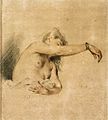Imitation (art of drawing)

When imprinting in the art of drawing , an unmarked, often previously moistened paper is placed flush on a drawing or fresh painting (clapped) and both rubbed on top of each other or printed with a copying press. The drawing or painting is transferred to the opposite surface as a mirror image, but mostly less so. Dry, powdery drawing materials are particularly suitable for this, such as broad-drawing pencils made of charcoal , chalk and red chalk . They allow the set-off by releasing excess pigment through targeted contact with the opposing surface.
The imitation (English counterproof , French contre-épreuve, Italian stampe sopra i disegni ) serves as a synonymous umbrella term for numerous transmission processes that use the same principle, including monotype , transfer printing , printing , squeeze drawing , folding impression , natural self-printing. See also the article Abklatsch (printing technology) .
history
The set-off occurs primarily in the art of drawing from the 16th to around the middle of the 19th century.
- Copy
Anne Louis Girodet-Trioson : Autoportrait (Contre-épreuve retouchée au crayon noir et à l'estompe) (n.d.)
Charles-Louis Bernier : Cimetière des Innocents (Contre-épreuve d'un dessin à la mine de plomb) (1786)
William Blake : The Man Who Taught Blake Painting in his Dreams (1819/20)
Raffael : Study (around 1514)
Antoine Watteau : Copy of two studies (1717/18)
Antoine Watteau : Study, chalk (1717/18) - copied original
literature
- Thomas Ketelsen (Hrsg.): Der Abklatsch - An art in itself , Volume 15 of the series The uncertain view , 102 p., Cologne 2014
Web links
- Wallraf-Richartz-Museum & Fondation Corboud , Cologne: The imitation. An art in itself , 29 August to 23 November 2014





